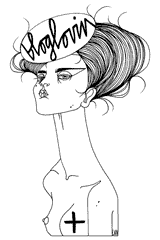You do not have jewlery to wear tonight? No problem! Try this! All you need is: Pierce the fuzzy ball with a safety pin and hang it on your regular earring!
Pierce the fuzzy ball with a safety pin and hang it on your regular earring!
Cool ah?
 Pierce the fuzzy ball with a safety pin and hang it on your regular earring!
Pierce the fuzzy ball with a safety pin and hang it on your regular earring!Cool ah?





















